- New Products
- Exclusive Gear
- Bushcraft Gear
- Containers
- Cooking
- Fire
- First Aid
- Food Gathering
- Knives & Tools
- Knife Collectors Corner
- Light
- Logo Gear
- Misc. Items
- Navigation
- Packs, Pouches & Bags
- Personal Care
- Repair Gear
- Shelter & Protection
- Signaling
- Urban Survival
- Water
- Writing Gear
- John's Books
- Bargain Bin
Weeds Can Feed
When we have guests over for dinner, we usually like to start the meal with a salad. When the salad is placed on the table, and after a bewildered examination by our guests, we are normally informed that the salad looks splendid, but then asked what is in it.
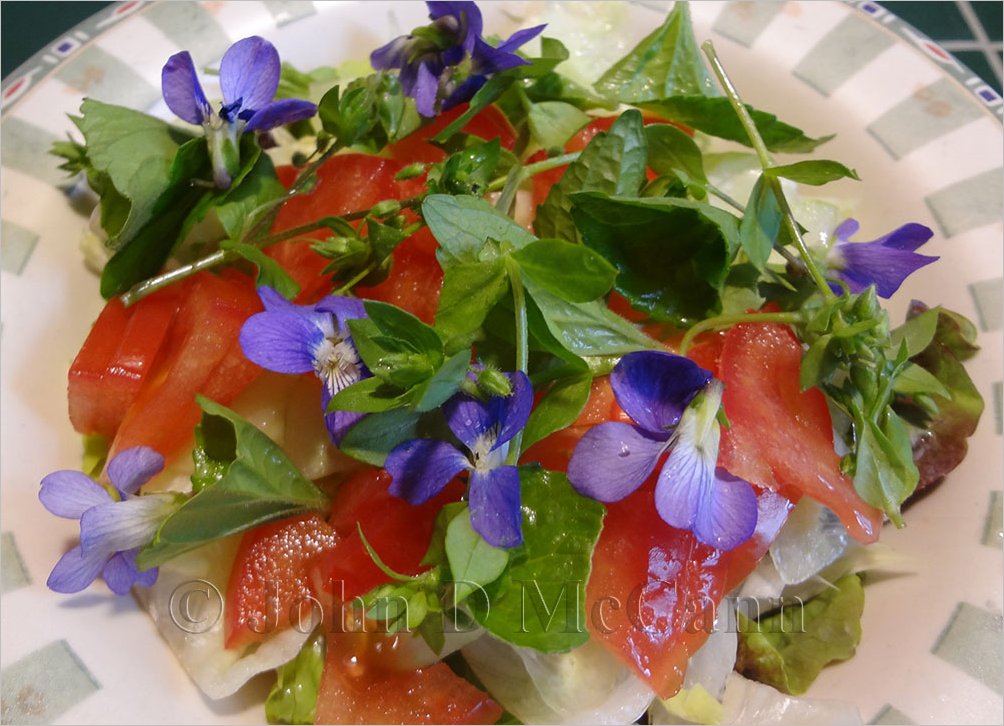 A salad made mostly from weeds in the yard, excluding the tomatoes.
A salad made mostly from weeds in the yard, excluding the tomatoes.
Our salads seldom resemble the usual mixture of lettuces and greens presented at your normal table and are often full of color. Yet the contents are rarely identifiable by the ordinary diner. I usually retort that the contents are merely weeds and that the main course will probably contain more. Although surprised at the outset, before the salad is completed, compliments from delicious to an epicurean's delight, gush forth from the guests.
Most people just don't realize the plethora of weeds around their yard that are edible, healthy, and delectable. Weeds are often pulled up around the yard and garden as a nuisance without realizing they can be as healthy and delicious as the vegetables grown in the garden. And best of all, weeds are free for the taking. So let's examine some of those weeds that can feed in the Northeast, where we reside.
In the early spring, you have the young Dandelion greens. The leaves of the dandelion are so toothed that it got its name from the French which means "lions tooth." Dandelions are well known, and usually dreaded, as the fuzzy headed yellow plant, that tends to take over your lawn. But in the early spring, before they form those pinnacles of yellow flowers, and are still in the small rosette of leaves stage, they are not yet too bitter to eat. At this time, the small leaves, especially the pale whitish portion just below the soil, can be a great addition to salads. Add a little olive oil, lemon juice, and a pinch of salt. As a potherb, these young leaves can also be boiled or steamed for 5-10 minutes. Either way, they are full of vitamins A & C. However, they do cook down, so collect plenty if you are using them as a potherb.
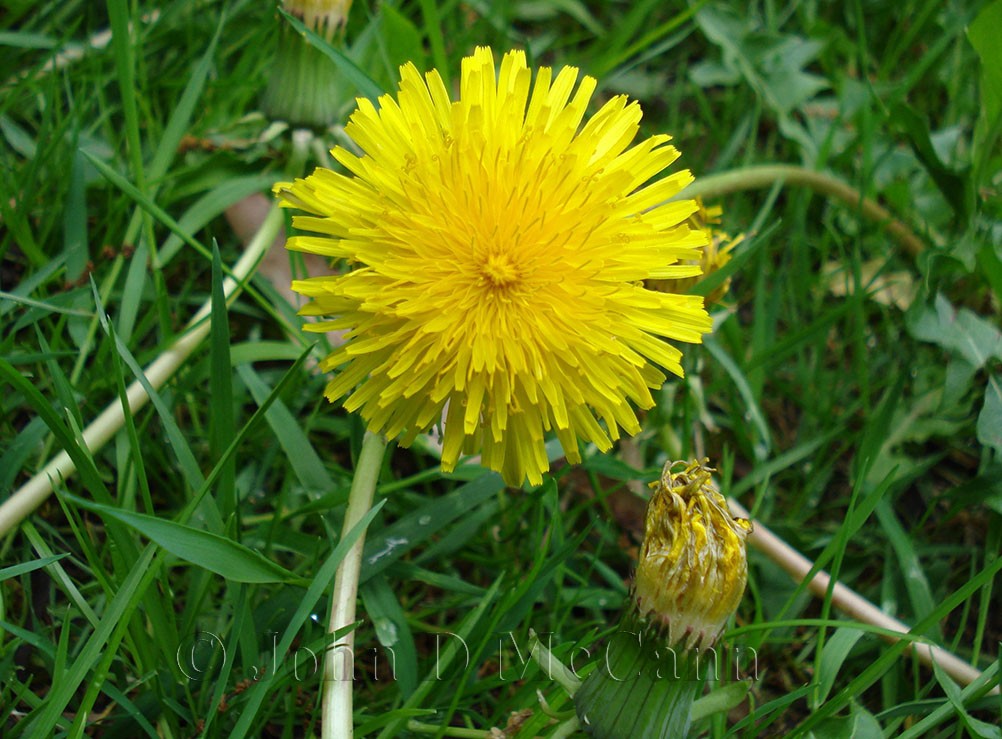 A close-up of a Dandelion Flower.
A close-up of a Dandelion Flower.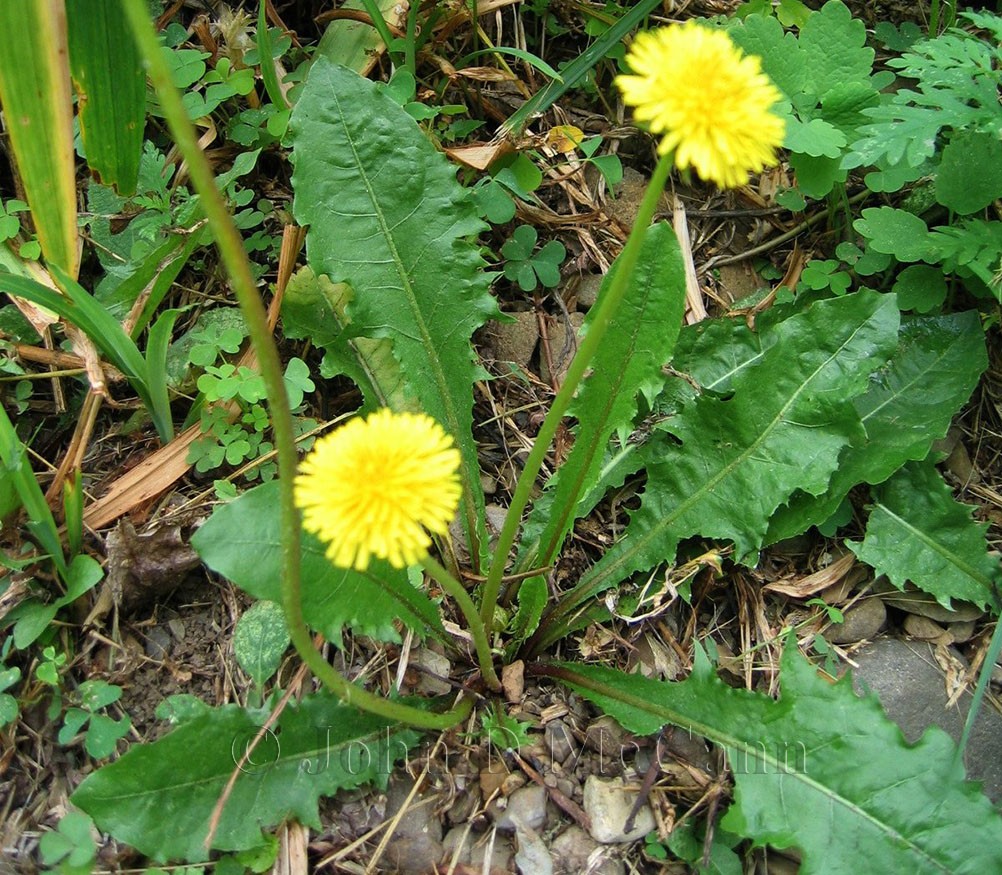 A view showing the leaves of the Dandelion.
A view showing the leaves of the Dandelion.
As the season progresses, and the flowers appear, dandelions become too bitter to eat. However, you can still use the yellow flower heads by dipping them in batter and deep frying them, like a fritter. As a last resort, you can bake the roots until brown and then grind them for use as you would any commercial coffee. Although a little bitter, it can be used as a coffee extender in an emergency situation, by mixing it with your commercial blend.
The Common Blue Violet is a spring flower which, at least on our property, seems to flower everywhere. Blue to violet in color, it has five petals with the lowest petal being longer and heavily veined. The side petals are bearded with long, thin, hairs on the inside portion. The leaves are heart shaped. Although somewhat bland in taste, both the leaves and flowers add a nice touch, with the blue flowers contributing a nice color, to a completed salad. They are also rich in both vitamins A and C.
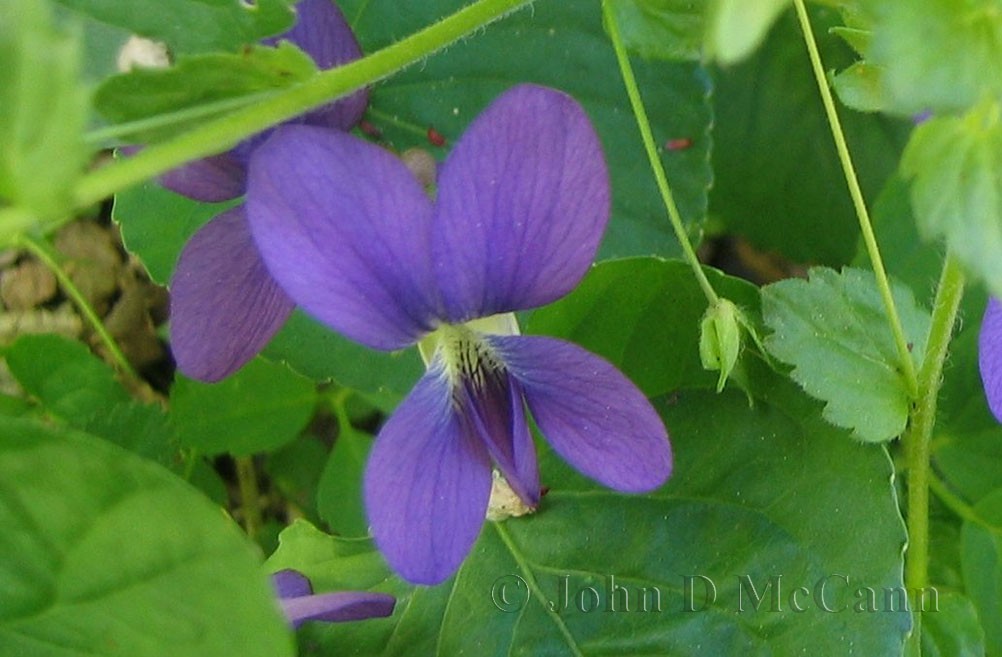 The Common Blue Violet makes a great addition to any salad.
The Common Blue Violet makes a great addition to any salad.
The Common Chickweed is another weed that appears everywhere and can be eaten all year long. If you remember where it grows, you can even find it growing under the snow in the winter, and harvest it for consumption. A small plant, normally laying flat on the ground, has a flower so small it normally goes unnoticed. Yet, if one was to examine it closely they would discern that the miniature flower is notched so deeply that it appears to have ten petals as opposed to its actual five. Common chickweed makes a nice addition to a salad and can be boiled or steamed for about five minutes for use as a potherb. Mouse Ear Chickweed has hairy stems and leaves but can still be used as an edible plant just like the Common Chickweed. The flowers look the same on both.
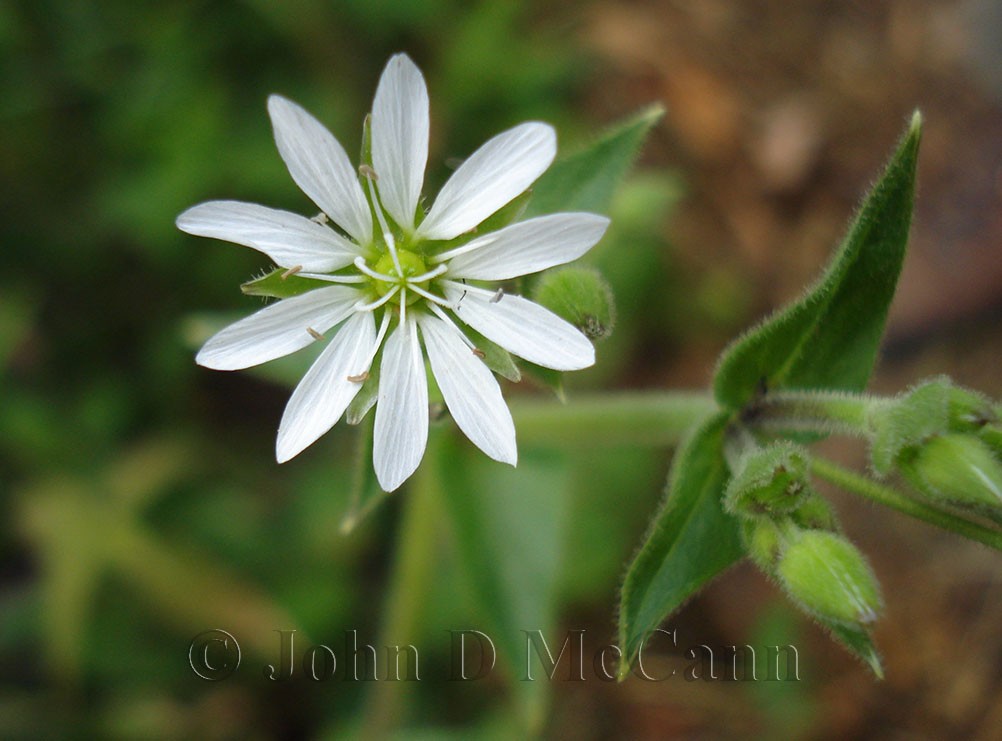 A close-up of a Mouse Ear Chickweed flower.
A close-up of a Mouse Ear Chickweed flower.
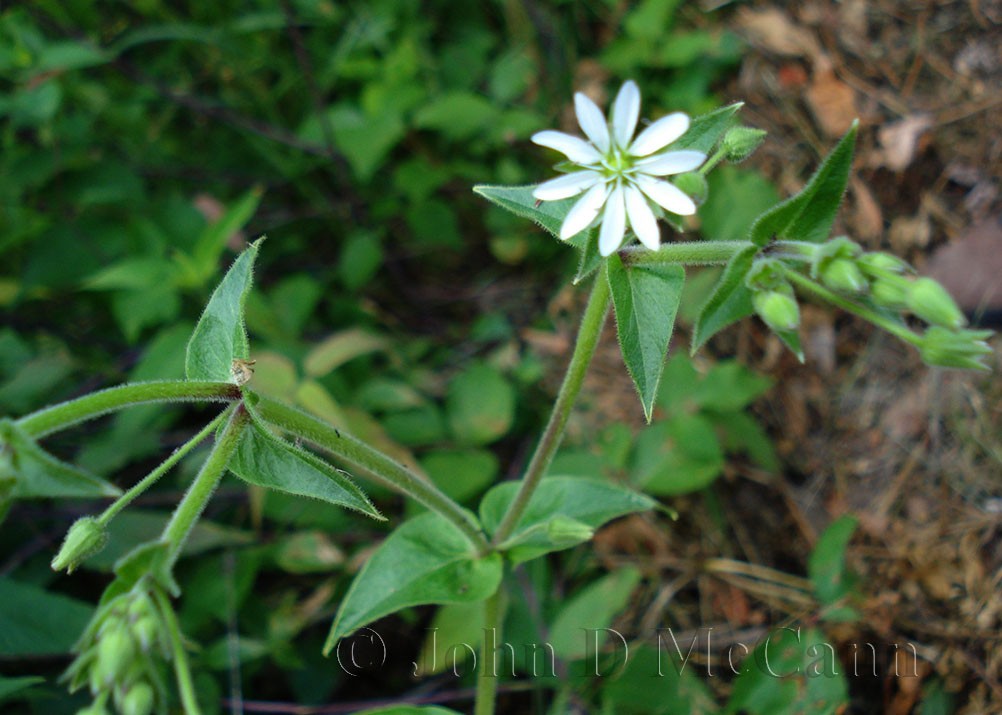 A view of the leaves and stems of the Mouse Ear Chickweed.
A view of the leaves and stems of the Mouse Ear Chickweed.
An often overlooked weed is Purslane, which to the chagrin of many, grows well in every garden and many other areas around the yard. It is a smooth prostrate plant with reddish-green stems, with small paddle-shaped leaves. It has leaves and stems that have a sweet-sour flavor and are mucilaginous. They are rich in vitamins A & C as well as calcium and phosphorus. They make a great addition to a salad raw and can also be cooked and pickled. The seeds can be used as well to make a nutritious flour.
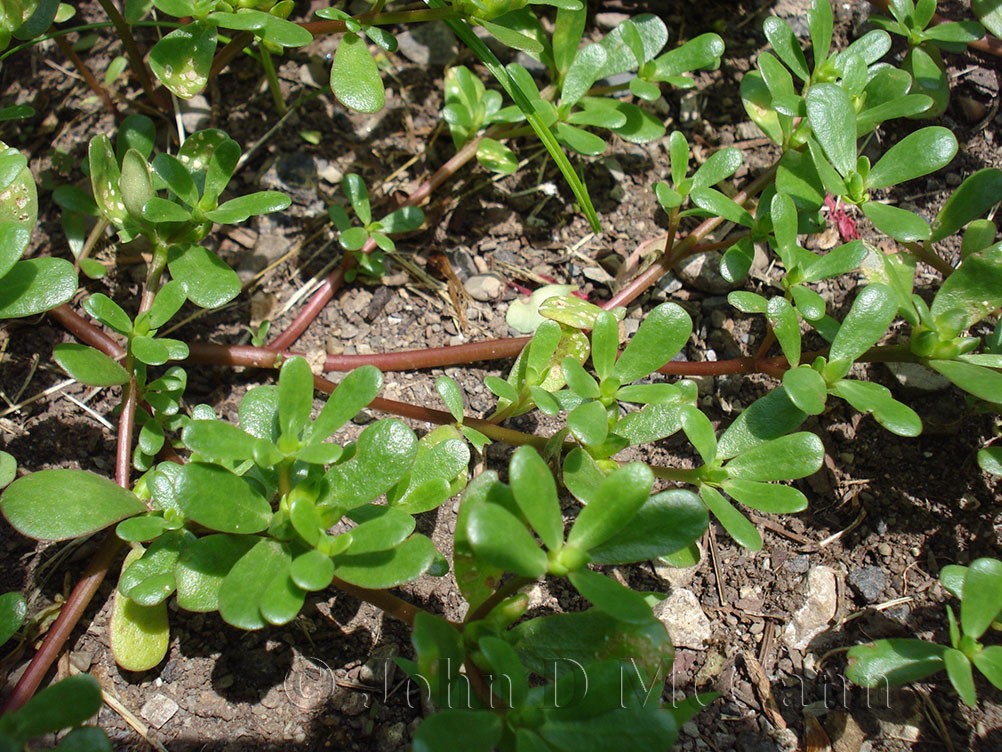 Purslane with it's paddle-shaped leaves and reddish-green stems.
Purslane with it's paddle-shaped leaves and reddish-green stems.
Once salad is completed, there is an abundance of other weeds that just keep filling our pots with steamed or boiled greens. In the spring, we can't wait for the Ostrich Fern Fiddleheads. Still all curled up at the heads, like a kitten against its mother, they are great steamed. And don't forget to leave some of the stems attached, as they taste as good as the fiddleheads. Unfortunately, once they uncurl, they become poisonous, so enjoy them when you can.
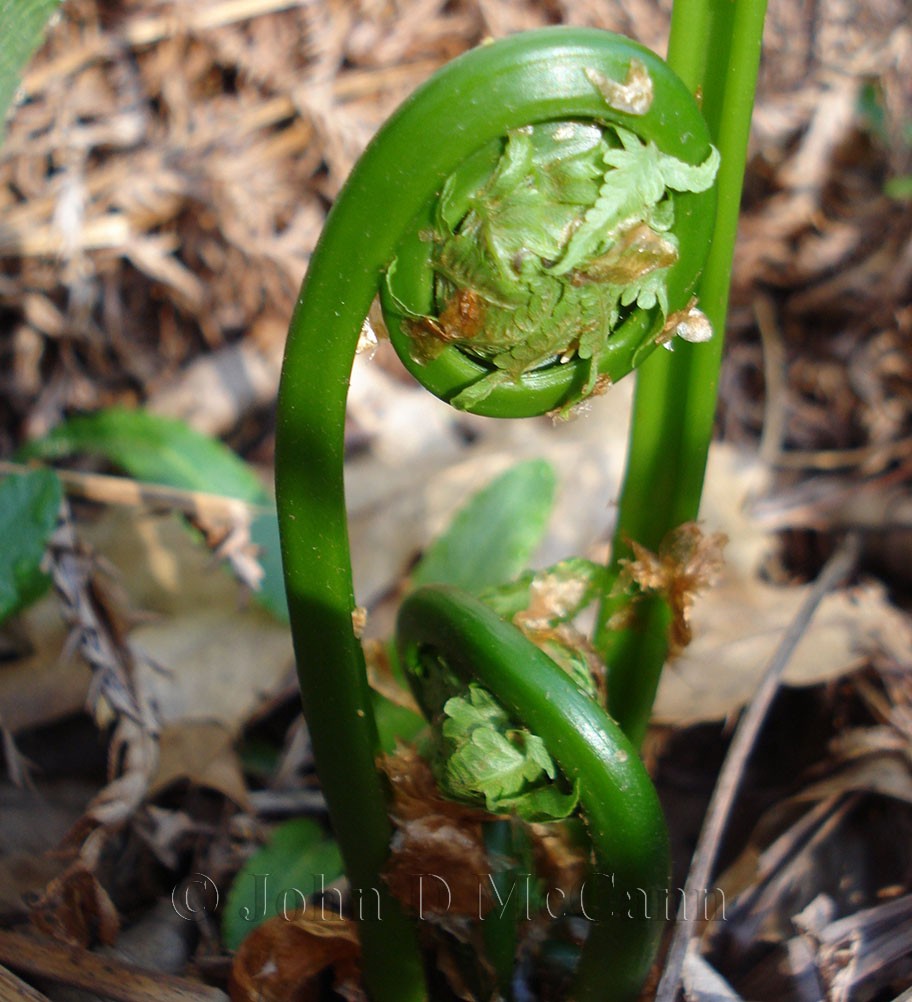 Fiddleheads of the Ostrich Fern ready to pick.
Fiddleheads of the Ostrich Fern ready to pick.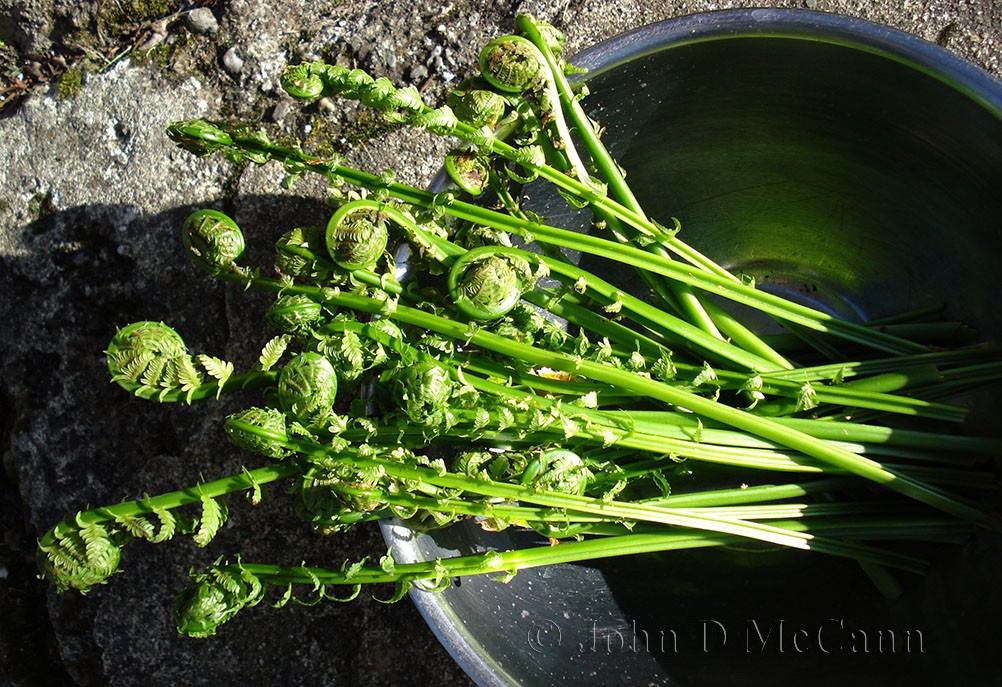 A bowl full of Fiddleheads of the Ostrich Fern with plenty of stem which taste as good as the Fiddlehead.
A bowl full of Fiddleheads of the Ostrich Fern with plenty of stem which taste as good as the Fiddlehead.
One of my favorites, all summer and early fall, is the Asiatic Dayflower. Often ignored, this little beauty is my preferred steamed potherb. It is a dainty little blue flower that has two large petals above and one diminutive white petal below. It has lance shaped leaves and it is those leaves that you collect and cook. We are fortunate to have a plethora of these graceful and attractive flowers in various areas of our property where it is shady or moist.
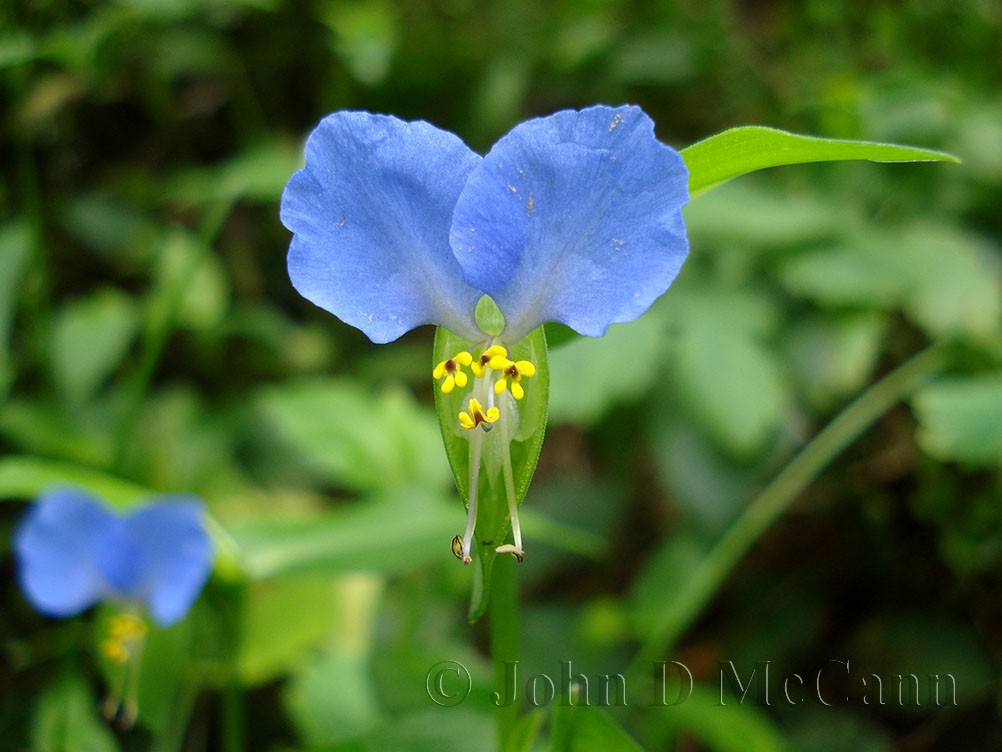 A close-up of the Asiatic Dayflower which is my favorite potherb.
A close-up of the Asiatic Dayflower which is my favorite potherb.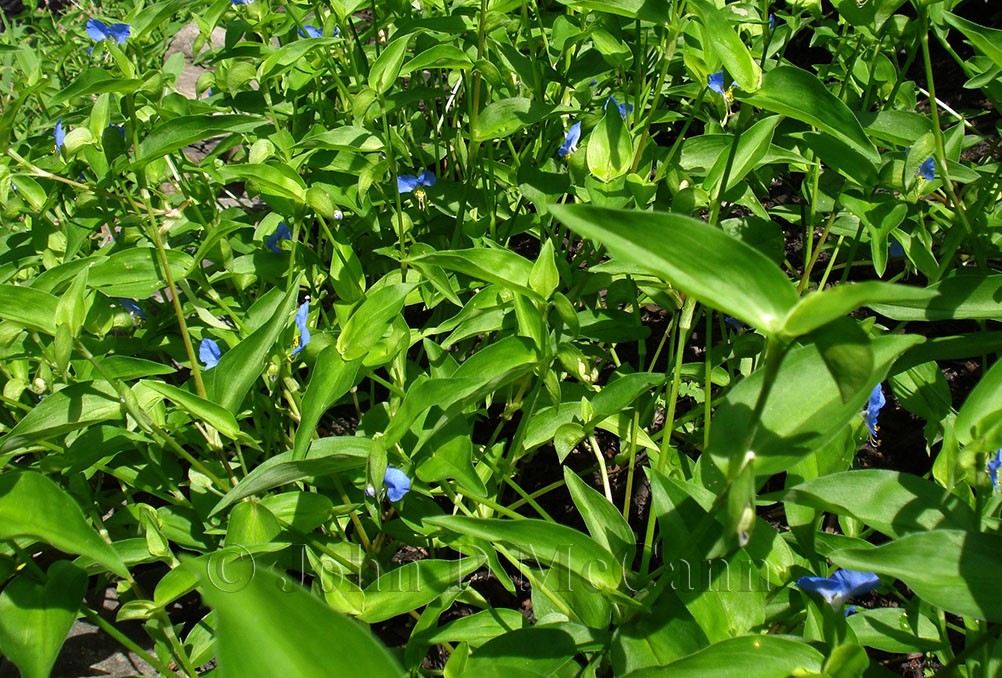 A bank full of Asiatic Dayflowers showing the lance shaped leaves.
A bank full of Asiatic Dayflowers showing the lance shaped leaves.
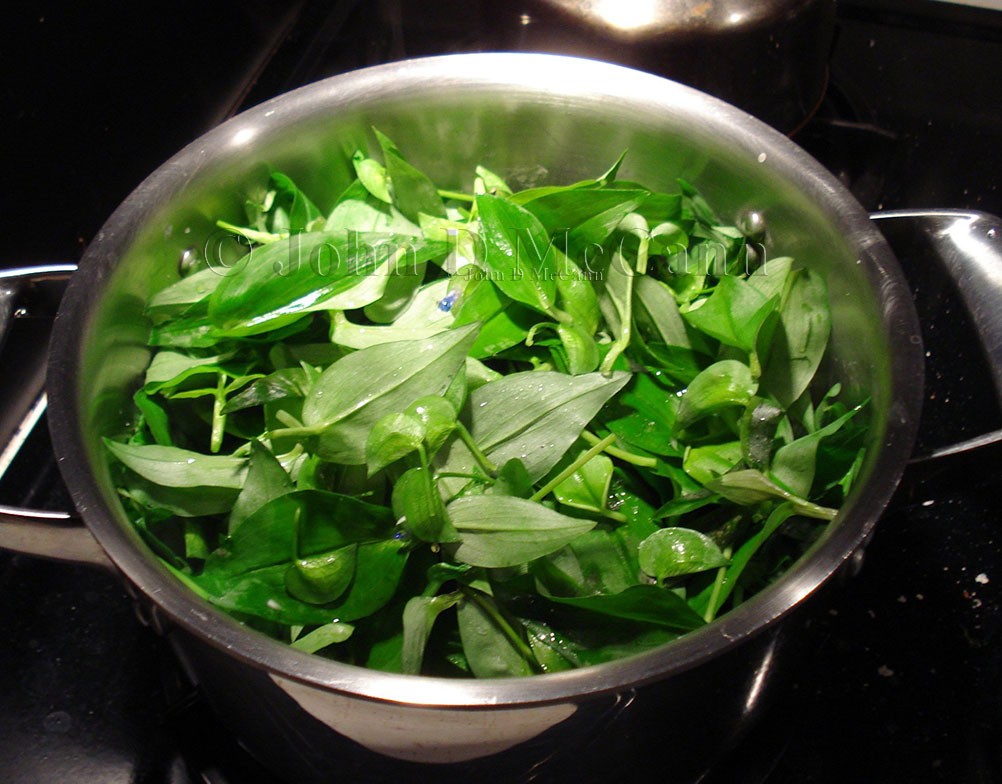 A pot of Asiatic Dayflower before it is steamed.
A pot of Asiatic Dayflower before it is steamed.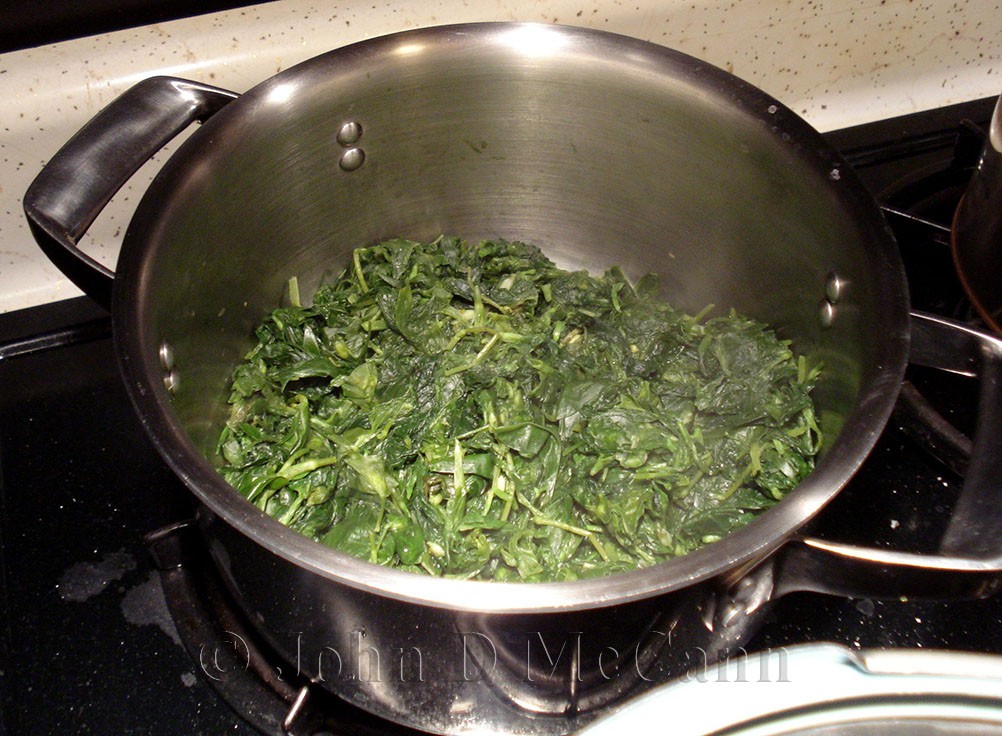 This shows how the Aisatic Dayflower cooked down after steaming.
This shows how the Aisatic Dayflower cooked down after steaming.
The Stinging Nettle is an excellent pot herb. Nettles have little stinging hairs on the stems and the leaves, so use caution when harvesting them. Gloves are recommended, and either keep your arms and wrists covered, or avoid having the plant rub on either. The Stinging Nettle has leaves that are coarsely toothed and are in opposite pairs every few inches on the upper portion of the stalk. The leaves are ovate to lanceolate in shape and usually have a heart-shaped base. Small greenish flowers appear in small, branching clusters, from the leaf axils. In the spring you can pick the upper two or three pairs of leaves, but by summer I recommend only the upper two. As a steamed or boiled potherb, it doesn't get much better than Stinging Nettle, and as soon as they are cooked, the stinging properties disappear.
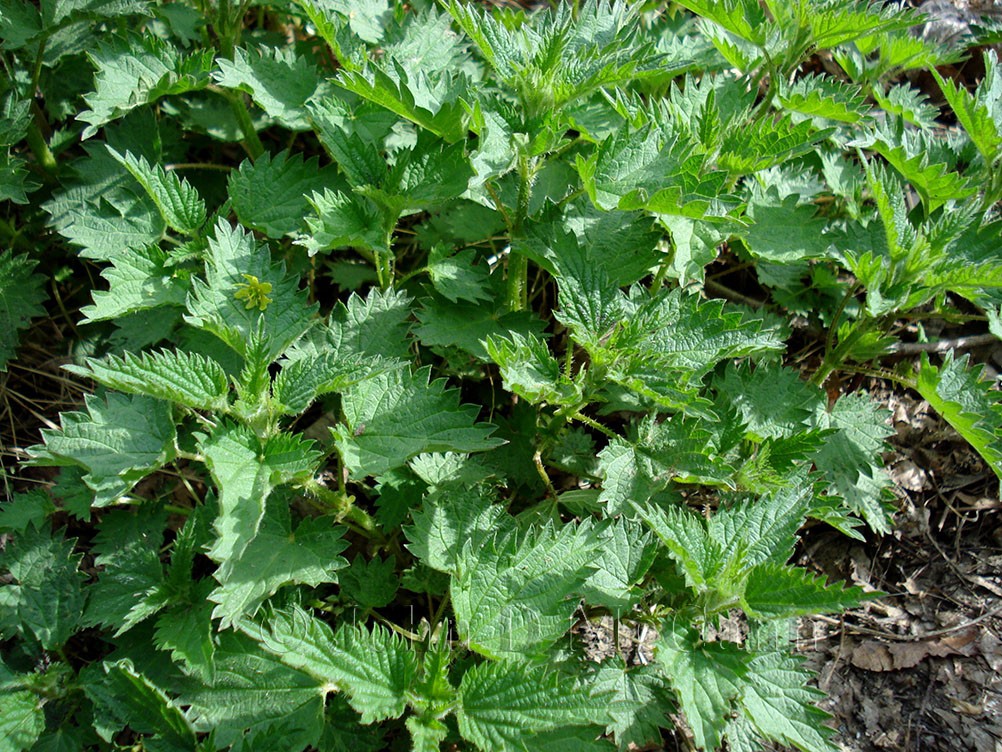 Although I recommend wearing gloves for picking Stinging Nettles, once they are boiled or steamed, they lose
Although I recommend wearing gloves for picking Stinging Nettles, once they are boiled or steamed, they lose
their sting. A great potherb!
Galinsoga is a weed that constantly tries to take over our vegetable garden. A low inconspicuous weed with slender forking stems, the leaves are broad, opposite, and coarsely-toothed. The miniature little flowers are only about one-quarter inch across with five tiny three lobed rays around a golden central disc. Again, it is the leaves that are eaten as a cooked green. Steamed or boiled, they are great served with butter. As with most potherbs, they really cook down, so pick plenty.
 A close-up view of the Galinsoga flowers.
A close-up view of the Galinsoga flowers.
Lamb's Quarters, also known as Goosefoot (because the leaves remind some of a goose's foot) and Pigweed, it is both, a weed that can be used raw in salads, or cooked as a potherb, and they are delicious both ways. The leaves, which get up to four inches long, are somewhat diamond shaped when mature and broadly toothed. They grow alternately from the stalk on petioles about half the length of the leaf. Although they are a dark bluish-green color on the top, the underside is usually covered with a whitish-gray powder. The small, upper most leaves on mature plants have more of a lanceolate shape and lack teeth on their margins.
Closely related to spinach, Lamb's Quarters can be eaten from spring through fall. In the spring, until the plant reaches up to twelve inches, you can normally use the entire plant as a cooked potherb. The tender upper leaves are great as an addition to a salad. As the plant gets larger, select the upper more tender leaves for cooking. Again, they really cook down, so pick a lot. It should also be noted that the Lamb's Quarters little black seeds, available in late fall, can be boiled and used to make a breakfast type gruel, or ground into flour. They are very nutritious.
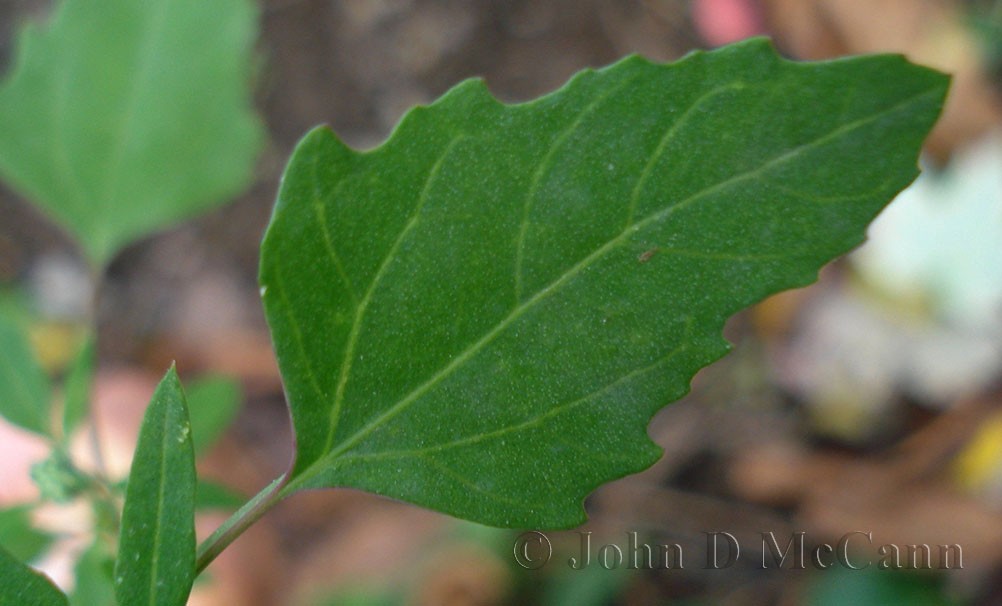 A close-up of a Lambs Quarter leaf. Lambs Quarter is a good potherb that also seems to grow everywhere.
A close-up of a Lambs Quarter leaf. Lambs Quarter is a good potherb that also seems to grow everywhere.
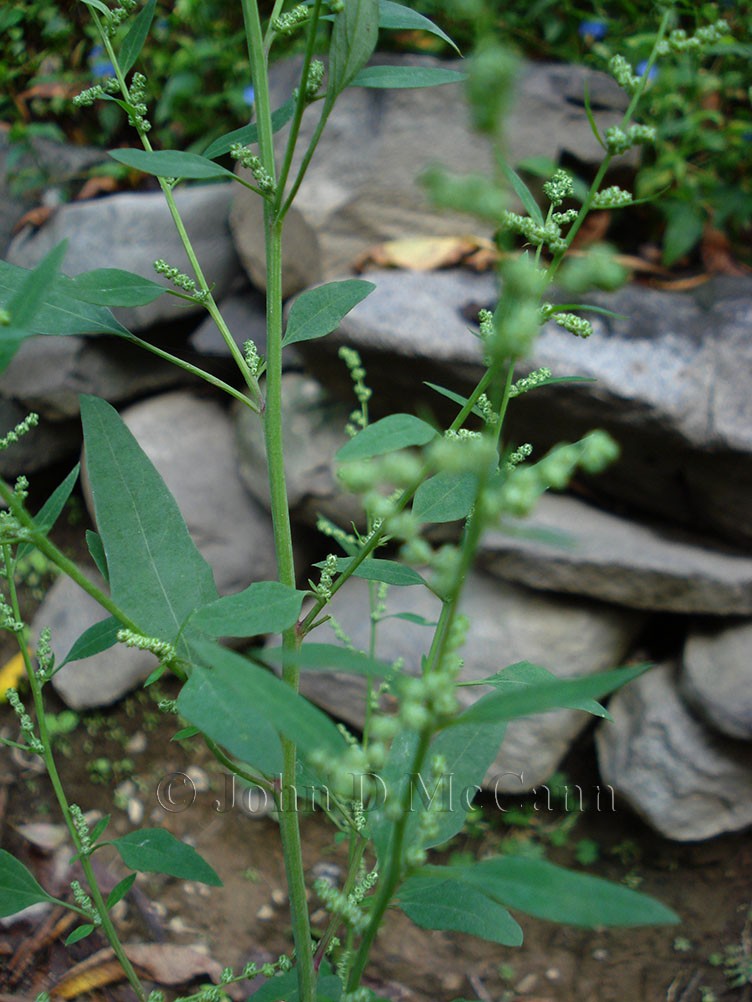 The small seed pods on the Lambs Quarter in the fall produce little black seeds that can be ground
The small seed pods on the Lambs Quarter in the fall produce little black seeds that can be ground
into flour or used to make a breakfast type gruel.
Amaranth is another good weed, that seems to love my garden. It has a course stout stem that averages about three to four feet tall, but are known to get as high six feet. The leaves are dull green and are ovate to lance shaped, with toothless borders, and are alternate on the stem. The tender leaves can be used in a salad and make a good potherb. In the late summer and fall, they develop flower clusters in the leaf axils and are dense. The seeds from these clusters can be used to make flour.
Lady's thumb is an acceptable potherb and the young leaves can also be used in a salad. It is an upright standing plant with tiny pick clusters of flowers and narrow leaves. It is unique in that each leaf has a dark triangular mark on it that resembles a thumb print, hence the name "Lady's Thumb."
If you are lucky enough to have Jerusalem Artichoke on your property, you are in for a treat. It can be considered a true survival food and one of the best! Although the flowers are pretty, it is the tubers underground that are edible. Some of these tubers, getting as large as a medium size potato, can be eaten raw by slicing them thin and adding them to a salad. The tubers can be substituted in recipes that call for potatoes. Locate them while they are still flowering, then dig up the tubers throughout the fall, and even the winter if the ground unfreezes. Although the consumption of the tubers have been known to cause flatulence, I find that prudent consumption reduces the consequence.
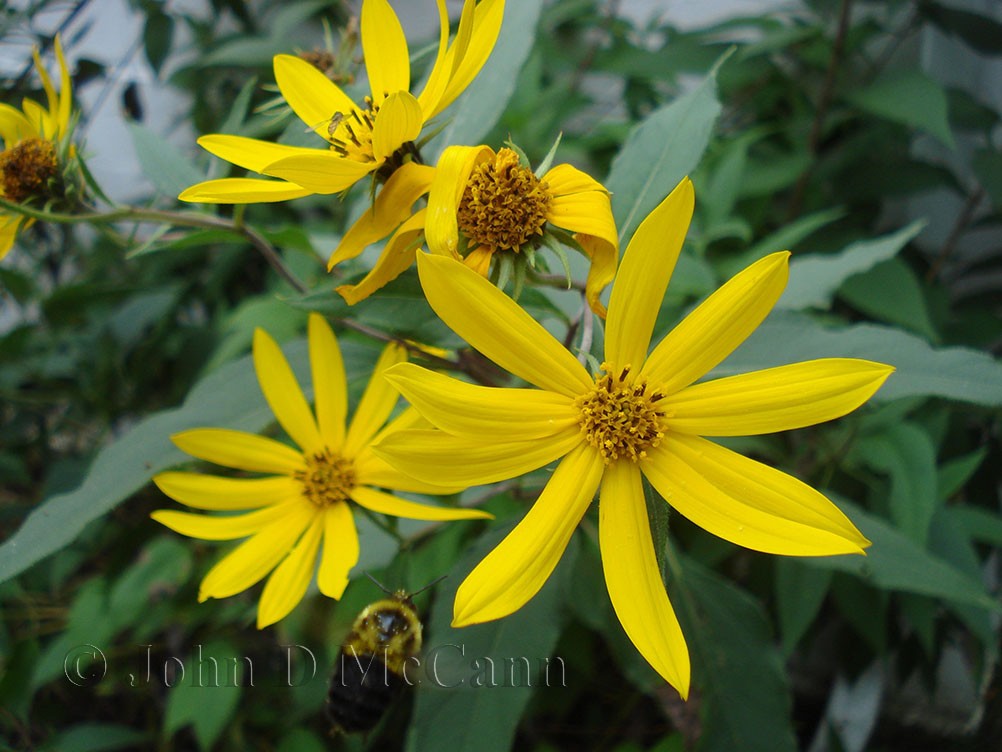 A close-up of Jerusalem Artichoke flowers.
A close-up of Jerusalem Artichoke flowers.
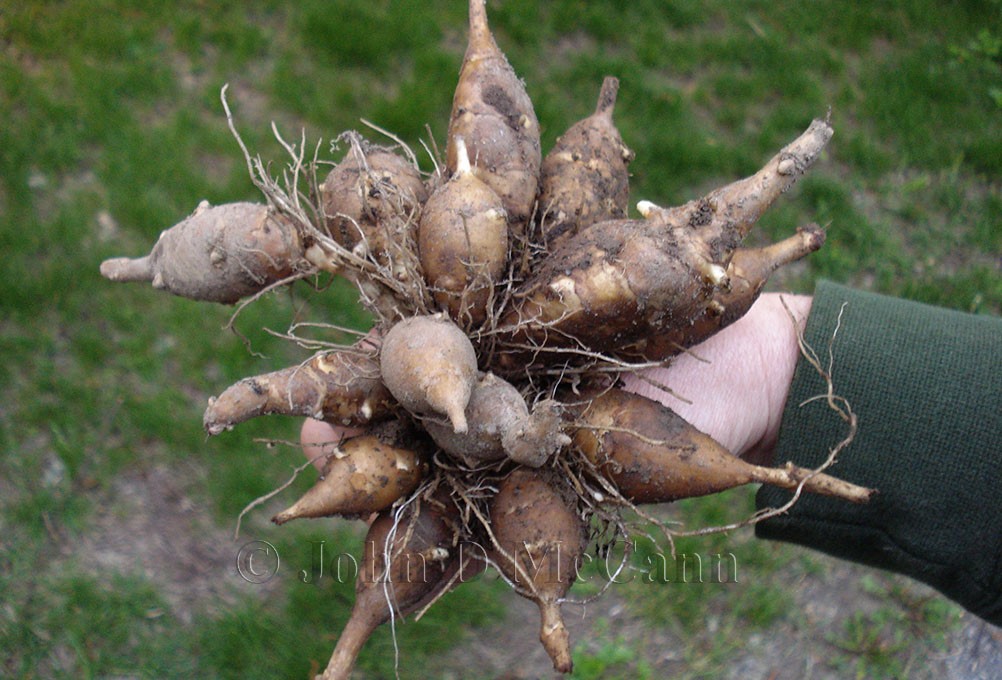 A handful of Jerusalem Artichoke tubers.
A handful of Jerusalem Artichoke tubers.
All of these plants grow wild around our property and they often provide almost as much eating as our garden. For those used as potherbs, like spinach, they all cook down so pick a lot. As you can see, weeds are everywhere, but are not all bad. They can be a healthy addition to any meal and are free for the taking. Remember, weeds can feed!
We hope you enjoyed this article and will help support our efforts by checking out our products. As always, Be Prepared To Survive!
Copyright © 2014 by John D. McCann
Warning: Never pick and eat a plant that you have not 100% identified as edible. There are many reference books and field guides which can help in the identification of edible plants. I also suggest a plant walk with an expert to help in the correct identification. On the east coast I recommend Wildman Steve Brill, and on the west coast, Christopher Nyerges.


